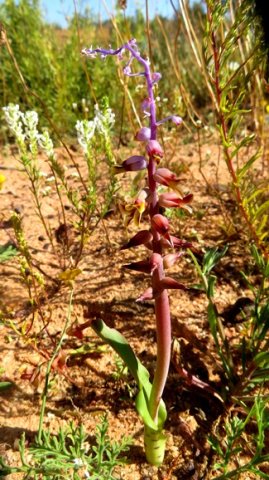Lachenalia mutabilis in three colours

Author: Ivan Lätti
Photographer: Thabo Maphisa
The tricolor Lachenalia mutabilis plant may appear in blue, red-brown and green sections. A flag for the west coast of South Africa flaunting these colours would be appropriate:
The sky is usually blue, cloud cover rare, less than in many other places. The vegetation, earth and rocks are often red-brown in the arid west that is getting drier. Green is tricky in these parts. It appears miraculously after rain but doesn’t last well. This makes grey a contender; unlikely though to be a popular colour for a flag.
For now, there is a youthful light green on the wavy leaf at the base. Sparse, dark blotches are scattered on its outer surface near the ground. The older flowers, likely to produce seed are well on their way to brown in the central part of the plant.
The blue up top is for those flowers that did not make it. Small, unfulfilled and high but not quite dry, they are proof of earlier big intentions that failed to materialise when resources ran out, as they usually do for this plant. When provisions offloaded is insufficient, the extremity is sold short, similar to the outback losing out in human society due to capacity limitations in the distribution system.
Why are the blue ones here then? They also serve who only stand and wait? Maybe so, as pollinator flight plans could well change in response to colours noted in the surroundings. One extra inflorescence colour as marketing or deception may well benefit the “real” or fully functional flowers below, sorely needing visitors and so ready to please.
Blue is for the human race said to signify all kinds of lofty things including desire, love, striving for the infinite, the unreachable and beauty. For plant and insect, the ubiquitous incentive to procreate may be construed as desire.
Striving for the infinite is, however, a real big idea to associate with the large majority of species in nature, as they lack consciousness and thinking. Track record confirms the strength of the survival tendency in both own body and through offspring, in all extant species on earth.
If a case may be made that the drive to live was weak anywhere, some extinct species might be considered as they have been overwhelmed by their challenges. This could, however, happen to any species from the sheer magnitude of the particular life challenges, not reflecting on the innate life forces being inherently weak; inadequate or unsuccessful here relates to the odds, not meaning halfhearted. Everything tries to live as best it can, its environment providing or withholding the necessary and the species lives or dies.
A key feature of all life is the genetic imperative to continue living if at all possible. It may not mean reaching a particular or universal vision of forever. More likely it means merely pushing on regardless as long as there is life, from day to day, season to season and generation to generation. The future is only tomorrow or tomorrow plus the unknown.
Life in every form "knew" and did this from long before there were brains around. It only started using brains for survival since their appearance as one more tool for achieving the universal objective of living. The principle being that everything available is used to further life.
Striving to keep alive is automatic, embedded as the shared, central message in all organisms, irrespective of their specific dialectics. It always translates into procreation at all costs, for the self, the own body, can’t last.

